Banyoro People and their Culture in Uganda
Who are the Banyoro People in Uganda? Bunyoro is a kingdom in Western Uganda. It was one of the most powerful kingdoms in East Africa from 13th century to the 19th century.
It is ruled by the Omukama of Bunyoro.
The current ruler is Solomon Iguru I, the 27th Omukama (king) of Bunyoro-Kitara.
The people of Bunyoro are also known as Nyoro or Banyoro (singular: Munyoro) (Banyoro means "People of Bunyoro"); the language spoken is Nyoro (also known as Runyoro).
In the past, the traditional economy revolved around big game hunting of elephants, lions, leopards, and crocodiles.
Today, the Banyoro are now agriculturalists who cultivate bananas, millet, cassava, yams, cotton, tobacco, coffee, and rice. The people are primarily Christian.
History and the Establishment of Bunyoro Kingdom
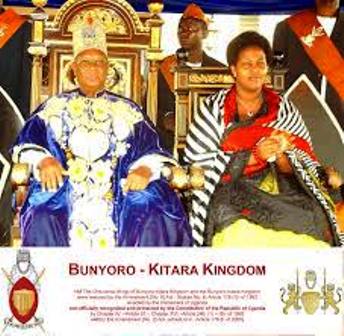 The King of Banyoro People and their Culture in Uganda
The King of Banyoro People and their Culture in UgandaThe kingdom of Bunyoro-Kitara was established following the collapse of the Empire of Kitara in the 16th century. The founders of Kitara were known as the Abatembuzi, a people who were later succeeded by the Abachwezi. Bunyoro Kitara Kingdom.
Due to its height, Bunyoro-Kitara controlled almost the entire region between Lake Victoria,Lake Edward, and Lake Albert.
One of many small states in the Great Lakes region the earliest stories of the kingdom having great power comes from the Rwanda area where there are tales of the Banyoro raiding the region under a prince named Cwa around 1520.
The power of Bunyoro then faded until the mid seventeenth century when a long period of expansion began, with the empire dominating the region by the early eighteenth century.
Bunyoro rose to power and controlled a number of the holiest shrines in the region, together with the lucrative Kibiro salt works of Lake Albert; having the highest quality of metallurgy in the region made it the strongest military and economic power in the Great Lakes area.
Reasons for the Decline of Bunyoro Kingdom in Uganda
Bunyoro began to decline in the late eighteenth century due to internal divisions.
Buganda seized the Kooki and Buddu regions from Bunyoro at the end of the century. In the 1830s, the large province of Toro separated, claiming much of the lucrative salt works.
To the south Rwanda and Ankole were both growing rapidly, taking over some of the smaller kingdoms that had been Bunyoro's vassals.
Thus by the mid-nineteenth century Bunyoro (also known as Unyoro at the time) was a far smaller state, though it was still wealthy due to the income generated from controlling the lucrative trade routes over Lake Victoria and linking to the coast of the Indian Ocean.
In particular, Bunyoro benefited from the trade in ivory.
Due to the volatile nature of the ivory trade, an armed struggle manifested between the Baganda and the Banyoro.
As a result the capital was moved from Masindi to the less vulnerable Mparo.
Following the death of Omakuma Kyebambe III, the region experienced a period of political instability where two kings ruled in a volatile political environment.
In July 1890 an agreement was settled whereby the entire region north of Lake Victoria was given to Great Britain.
In 1894 Great Britain declared the region its protectorate. In alliance with Buganda, King Kabarega of Bunyoro resisted the efforts of Great Britain, aiming to take control of the kingdom.
However, in 1899 Kaberega was captured and exiled to the Seychelles and Bunyoro was subsequently annexed to the British Empire.
Because of Bunyoro's resistance to the British, a portion of the Bunyoro kingdom's territory was given to Buganda and Toro.
The country was put under the governance of Bugandan administrators. The Banyoro revolted in 1907; the revolt was put down, and relations improved somewhat.
After the region remained loyal to Great Britain in World War I a new agreement was made in 1934 giving the region more autonomy.
Bunyoro remains as one of the four constituent kingdoms of Uganda, along with Buganda, Busoga and Toro.
Contemporary society of Bunyoro Kingdom
During the first regime of Milton Obote, the Kingdom of Bunyoro was forcefully disbanded in 1967.
The kingdom, together with three others, Buganda, Busoga, Toro, remained banned during the regime of Dictator Idi Amin (1971–1979) and the second regime of Milton Obote (1980–1985) and remained banned until 1993.
In 1993 the Kingdom was re-established and in 1995 the new constitution of Uganda was made, allowing and recognizing, the Kingdoms. The current Kingdom covers the districts of Buliis District, Hoima district, Kibaale District, Kiryandongo District andMasindi District.
According to 1997 projections, the total population of the Kingdom is between 800,000 and 1,400,000 (depending on sources) living in 250,000-350,000 households.
96% of the population live in rural areas, and only 1% of the population uses electricity for lighting and cooking.
More than 92% of the population are poor, and has earnings more than half that of the Ugandan national average, and about 50% of the population is illiterate.
The economic potential in the region is very large, with the Kibiro salt works and the possibility of large oil, gas, iron ore and precious stone.
During the first decade of the 2000s, sizeable deposits of crude oil have been discovered in the area.
The area also has large rainforests with an abundance of hardwoods including mahogany and ironwood.
The Omukama and the other leaders of the area are planning to establish a university that will primarily focus on teaching relevant skills with regards to work in the extraction of natural resources.
The university will also work to preserve the high level of cultural heritage in the area.
The King is in general doing a lot of work to improve the living standards of the people.
Relations are maintained with the European community via the development organization Association of the Representatives of Bunyoro-Kitara.
The King is also working to maintain the traditional bunyoro culture, but in the same time altering the honors of the kingdom in a way that they can be compared to western standards.
The First Bunyoro Kingdom Public University
On 7th of April of 2011, The National University of Criminal And Security Sciences (The NUCSS) was bestowed with the Royal Charter of Incorporation by His Majesty Omukama Rukirabasaija Agutamba Solomon Gafabusa Iguru I and it became the first public university of the Kingdom.
The university imparts certificate, diploma, bachelor, master and doctorate level courses in the disciplines of criminology, security sciences, police studies, law, business administration and other contemporary disciplines.
This is the distinguished public university of the kingdom having a large number of students around the globe.
Banyoro People Origins, Traditions/ Marriage and Relations
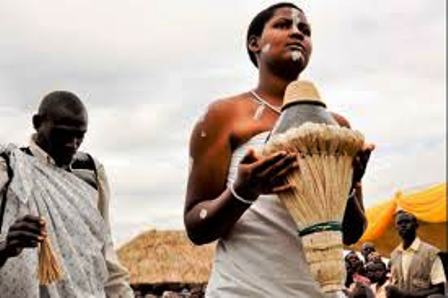 Banyoro People Origins, Traditions/ Marriage and Relations
Banyoro People Origins, Traditions/ Marriage and RelationsThe Banyoro, ever had them speak? So softly, humbly or even soothingly they utter their greetings.
I and Imagine so many other people have wondered how they react when they are mad.
The Banyoro lived in scattered settlements in the populated parts of their country and their homesteads were rarely more than shouting distance from one another. Politically, they were organized under a King (Omukama).
Tradition marriage among the Banyoro
Bride price in Bunyoro is called Omukaaga, and requires that six items are taken, whether goats, chicken etc but of course these days it can be anything from cows to money, not necessary numbering six.
But the name of Omukaaga (as official bride price) remains staunchly in Bunyoro kingdom.
Traditionally, looking for a suitable partner was a matter involving the family of the boy and that of the prospective bride. The girl’s contribution to the whole processes amounted to nothing more than giving her consent.
The first step was like it is today; a mutual attraction between the girl and the boy with a sexual relationship readily entered into. This was followed by establishment of a domestic arrangement.
Formalization of payment, if any, would normally follow but would not precede these arrangements. There was a tendency for boys to find girls from the same locality. In fact few would look for wives from beyond their villages.
Birth of a New Member in a Nyoro Family
A few months after a child was born, three months for a boy and four months for a girl, a simple ceremony would be held at which the child was given a personal name along with one of the traditional Mpako names.
The name could be given by a parent, grand-parent or some other relative. But if the father of the child was known and present, he had the last word. The names given differed considerably. A few of them were family names handed down in particular clans to commemorate, for example, a relative or some feature on the child or some circumstances surrounding the child’s birth.
There were special names for twins and those immediately following them. However, the majority of other names portrayed the state of mind of the persons who gave them.
Most names were real words which were used in every day speech. The general theme of the names rotated around the constant imminence of sorrow or death, the experience or anticipation of poverty and misfortune and the spite or hatred of one’s neighbors.The names which related to sorrow and death include; Tubuhwaire, Bulewenda, Buliarwaki, Kabwijmu, Alijunaki, Tibanagwa and several others.
The names associated with poverty include;, Bagamba Bikanga, Baligenda, Babyenda etc.
The names intended to portray the spite of neighbors included;, Itima, Tindyebwa, Nyendwoha, Nsekanabo, Ndyanabo, Tibaijuka and many others. Almost all the names portray that there were three things which the Banyoro feared very much, namely; death, sorrow and poverty..
Traditional Perception of Death of among the Banyoro/ After death Ritual in Bunyoro Kigdom
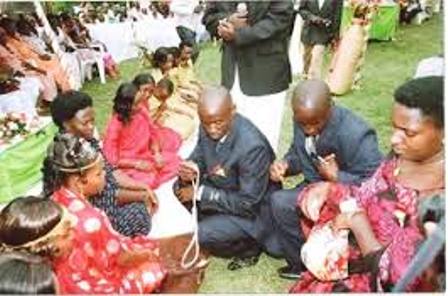 Traditional Perception of Death of among the Banyoro/ After death Ritual in Bunyoro Kigdom
Traditional Perception of Death of among the Banyoro/ After death Ritual in Bunyoro KigdomDeath was almost always believed to be the work of evil magic, ghosts, or similar. Gossiping was believed to magically affect or harm people.
Death was viewed as being a real being.
When a person died, the oldest woman of the household would clean the body, cut the hair and beard, and close the eyes of the departed.
The body was left for viewing and the women and children were allowed to cry/weep, but the men were not.
In case the dead was the head of the household, a mixture of grain (called ensigosigo) was put in his hand, and his children had to take a small part of the grain and eat it - thus passing on his (magical) powers.
After one or two days, the body would be wrapped in cloth and a series of rites would be carried out. The following rites are only for heads of family:
§ The nephew must take down the central pole of the hut and throw it in the middle of the compound
§ The nephew would also take the bow and eating-bowl of the departed and throw it with the pole
§ The fireplace in the hut would be extinguished
§ A banana plant from the family plantation and a pot of water was also added to the pile
§ The family rooster had to be caught and killed
§ The main bull of the family's cattle had to be prevented from mating during the mourning by castration
§ After four days of mourning, the bull would be killed and eaten, thus ending the period of mourning
§ The house of the departed would not be used again
The burial would not be done in the middle of the day, as it was considered dangerous for the sun to shine directly into the grave.
As the body was carried to the grave the women were required to moderate their weeping, and it was forbidden to weep at the grave.
Also pregnant women were banned from participating in the funeral as it was believed the negative magical forces related to burial would be too strong for the unborn child to survive.
After the burial the family would cut some of their hair off and put it onto the grave. After the burial, all participants washed themselves thoroughly, as it was believed that the negative magical forces could harm crops.
If the departed had a grudge or other unfinished business with another family, his mouth and anus would be stuffed with clay, to prevent the ghost from haunting.
A Bunyoro Year
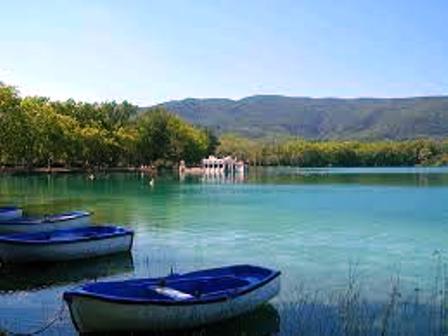
A typical year in Bunyoro is divided into 12 months and it is quite clear what work are to be done these months:
January (Igesa), there would be harvesting of millet
February (Nyarakarwa) there was not much work
March (Ijubyamiyonga) fields were prepared for planting sesame
May (Rwensisezere) there was not much work
July (Ishanya maro), women would prepare fields for millet
August (Ikokoba) was the months of burning grass in the millet fields
September (Isiga) was for planting millet
October (Ijuba) was a month of weeding
November (Rwensenene) was named after grasshoppers
December (Nyamiganura or Katuruko) was a month of rejoicing and festivities as there was little work to occupy the people.
The Empaako Tradition of banyoro and batoro people
Most unique to this tribe is their tradition of pet-names, which are accorded every Munyoro or Mutoro in addition to their traditional and religious names.
Gerald Businge says that the pet-name, Empaako is one thing that will readily identify a Munyoro or a Mutooro.
He explains that Empaako is a special name of endearment used to show love and respect, for salutation and by children to refer to their parents and elders.
"It is okay among the Banyoro and Batooro not to know one's surname or religious names but everyone is expected to know another person's pet name because it is what is used more often.
When a Munyoro or Mutooro meets another Munyoro or Mutooro, the first thing is to ask the other person's Empaako, and then greet the person using the pet-name," explains Businge whose pet name is Ateenyi
Unknown to the rest of us non-Banyoro, however, is how important this pet-name is to the people that use it.
"If I want to praise someone or show gratitude or even ask a special favor, I use their Empaako to appeal to them more.
It has a special feeling it creates in a Munyoro or a Mutoro when you call them with their Empaako," explains Businge.
He further discloses that the Empaako can be the Banyoro's Achilles' heel!
"It is difficult for me to deny someone something if they refer to me by my pet name when they are asking.
If you want a favour from a Munyoro or a Mutooro, just try calling them their Empaako before you ask the favour," he elaborates.
He says that when his mother wanted him to do a tedious task without complaining, she would call him his Empaako before assigning and he would do beyond the mother's request.
The Empaako is thus a social tool for harmony, encouragement and respect, which can be used to refer to people and relations comfortably.
"When I first left Bunyoro and Tooro, I couldn't believe how people can exist without theEmpaako.
A greeting without Empaako was like having food without source, or any tasteless endevour you can think of," Businge says, explaining just how important these pet names have come to be for the people who use them.
Ironically though, like most of the other Banyoro, Businge, despite his passion about the Empaako, has no idea where these precious pet names originate or what they really mean.
"All I know is that when I grew up, I found them in existence and every person is supposed to have one.
I don't even know whose choice it was that my Empaako is Ateenyi or why it is that particular one I was given," he says.
He however knows that these names are related to certain things. "Ateenyi is Ekijoka Kya Muzizi-the snake that resides in River Muzizi that separates present day Tooro and Bunyoro, bordering Kibale and Kyenjojo districts."
Why he was named after a snake, he neither knows nor shows any negative concern, he is just evidently proud of his pet name!
Isingoma John, on the other hand, knows that he is called Amooti because he was born a twin. "As the older twin, I'm automatically called Amooti and the younger twin (name Kato) Abooki. Otherwise I wouldn't know why I was given that pet name," he confesses.
According to www.bunyoro-kitara.com pet names are decided upon by the parents of the child. Originally when a baby was born in Bunyoro, it was given a Kinyoro name, which is a phrase or words with meaning, and the mpaako or pet-name, save for the twins and the child who comes after them who have special traditional holdings and pet names.
Male twins are named Isingoma and Kato- respectively, and the female twins Nyangoma and Nyakato with the pet names Amooti and Abooki respectively. OrAmooti and Adyeeri respectively. The child that followed was called Kiiza and Amooti for her/his pet-name. The Christian (or muslim) names attained through baptism were a Christianity influence.
Origin of Pet-Names in Banyoro and Batooro People of Uganda and their Meaning
Pet names do not have meanings in Runyoro but are rather corruptions of words in Luo language, original language of the Luo Babito who according to Gideon S. Were and Derek A. Wilson in their book 'East Africa Through A Thousand Years' invaded and colonized Bunyoro from the North about the beginning of the sixteenth century.
According to Okot P'Bitek(RIP) a reknown poet and writer in his book 'The Religion of the Central Luo' the 'empaako' is an Acholi word meaning 'praise'.
In Acholi language,abooki means 'I have narrated to you', Abooli 'I have lied to you', Ateenyi 'I have left you' and Adyeri 'I'm your friend'.
Important to note is that the king, and only the king, has two pet names. "When one becomes king they retain their original Empakko given at birth.
Okaali is a pet name specially reserved for the king and can not be used by the ordinary person," Businge elaborates.
At official functions, the King (Omukama) will thus be saluted with 'zoona okali' to which he does not respond, for after all he is the king.
The only other tribe in Uganda that uses pet names is the Batoro, who in fact though residing in a different kingdom have their origin in Bunyoro-Kitara thus sharing similar customs with very insignificant differences.
"The Batooro respect the pet names more than the Banyoro," says Isingoma Amooti explaining that unlike the Banyoro, the Batooro reserve the four pet names of Araali, Abaala, Achaala and Apuuli exclusive for the men.
Isingoma also says that though the two tribes speak the same language, they pronounce their words differently. "The Batooro have more Nkole influence and it shows in their pronunciation of words," he explains.
The Tooro Kingdom was originally a province of Bunyoro-kitara until 1830 when Prince Kaboyo, one of the sons Nyamutura, the king of Bunyoro at the time rebelled and declared Toro independent. Becaue of the love for his son, Nyamutura let son be. The Batooro and Banyoro are therefore one people residing in different kingdoms.
Banyoro People and their Clans
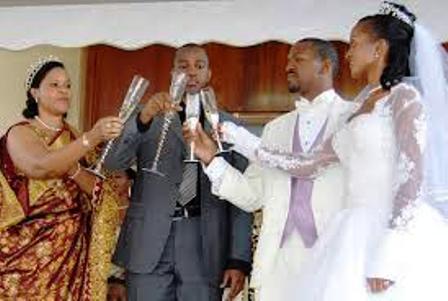 The Babito clan one of theBanyoro People and their Clans
The Babito clan one of theBanyoro People and their ClansLike other neighbouring tribes like Batooro and Baganda, the Banyoro have clans (Ekika). The clans, which include among others the Baruli, Bagahya, Bayaga, Basita, Bapiina and the Babito, which is the royal clan that provides the kings for the kingdom among others. The clans are based on patrilineal descent. That is, every child becomes a member of the father's clan.
Though every clan has a totem, the totems are not in any way related to their clans or their names. Businge for instance explains that he is sure the clans of Basiita, Bapiina and Babiito share the same totem of the engabi (antelope or bushbuck).
Love and Marriage Among the Banyoro
The Banyoro and Batooro in contrast with most of the other African traditions are free and liberal about love matters. It is for instance the only tribe I know so far where there is no punishment for pre-marital pregnancy. This is and has been the norm even in ancient times. Yudesi Tibasaaga Amooti, a Munyoro lady in her 70s says she got pregnant before she got married with a man who had two wives already.
"I got married to another man as his second wife though because my father did not want me to become a third wife," says Amooti adding that she finally got divorced and went back to her father's home when she had a misunderstanding with her co-wife.
Batooro are also known to freely marry across races. The restriction is on marrying clan mates who are believed to be a group of descendants from the same ancestors thus are blood relations.
"It is only the royal clan of the Babito who are allowed to marry from the same clan in an effort to maintain their 'blue blood lines'," explains Amooti.
The task of finding a spouse was otherwise a parent's affair in the ancient Bunyoro-kitara kingdom. The parents either found spouses for their children through antenatal betrothal, kuswera mu matunda where a man whose wife was pregnant offered the unborn child to a close friend.
In this case that child attained the status of wife at an early age and was handed over at around 6years of age to be groomed by her future mother-in-law. The boy to whom she is betrothed is however ignorant of this information.
Those who are not betrothed would begin to prepare for marriage in their puberty with the girls trimming their hair and nails and smear a special ghee on their skin. Personal and family background is considered with special attention being paid to avoid families with chronic or hereditary diseases.
When a suitable girl is spotted, the groom's family sends a go-between, kiranga obuko to announce their intentions to her family. On his first visit, accompanied by a few kinsmen, kiranga obuko is vague on his intensions only asking for friendship with the family and presenting one large goat and some pots of beer with a promise to visit again.
"It is on a second visit that he declared his real intensions," explains Tibasaanga Amooti. "All the girls in the family are assembled before him so he can declare his choice."
Meanwhile the girl's family would try to learn about the boy's family. Throughout the ordeal however, the girl's family assumed airs of haughty pride while the groom's remained humble. When the groom's family's request was granted, they knelt down and thanked their host.
Next will be the groom taking over beer over which was a license to discuss the bride price, amarwa gekicwa muhendo. Families usually married from families of the same status. Bride price comprised cows, goats and many pots of beer.
Payment of the bride price (Omukaaga) marked the engagement of the couple, which was symbolized by a string of animal skin, engonge, tied on the wrist of the couple.
In wait for the wedding day, the bride is exempted from chores, smeared with ghee and a type of red soil to make her skin smooth. She is also kept indoors.
For the Banyoro, the fatter the woman the better. During this the early times, the bride to be also received a range of presents/gifts, ensagalizi, from her parents and relatives ranging from straw mats, baskets and backcloth.
She took with her a bag of incense made out of dried and smoked papyrus reeds and scented herbs which she put in the bedroom to enhance the smell and arouse the husband.
Giving The Bride Away in Banyoro Traditional Culture
Amidst a special send off song, ijoooje, sang by her paternal aunties, abaisenkati, the bride was taken at night. The abaisenkati however arrived earlier in the evening where in a nearby bush (hakasaka) they gave their niece some marriage tips.
The bride's father lets is daughter sit on his lap four times to officially bid her farewell and bless her marriage. This is called okubukara.
The in-laws then sang engoma nyabahuma, begging to leave. Just when the bride was about to leave the house, amidst the women's crying for their departing member, one of her male cousins lay in the doorway to prevent her from leaving. The only way to get rid of him was for the in-laws to give him 10 cowrie shells. It is this cousin that would then carry her on his back and whenever the entourage stopped to rest, the bride sat on her aunt's lap
The Welcome at Her New Home
The first person the bride encountered at her new home was the senior wife in the household or wife of one of the brothers-in-law with a gourd who closed a bark cloth curtain in the doorway as she said, "oginsangiremu, Oliginsigamu (you found me in this house and you shall leave me here)".
The essence was that the new bride should never attempt to chase away another wife.
She then handed the gourd to the bride implying, 'you are now my co-wife come in and churn'. Inside the house the groom sat on his father and mother's laps four times respectively. This was okubukuara a sign of welcome and acceptance of the girl.
The First Sexual Relations among the Newly Wed Banyoro People
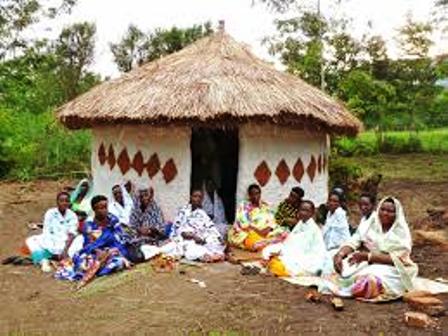 The First Sexual Relations among the Newly Wed Banyoro People
The First Sexual Relations among the Newly Wed Banyoro PeopleOn their first night before 3am, a son to one of the groom's sisters, omwiha, climbed up the wall and crowed like a cock. "Then, the bride's aunt who was still with them holds the bride's hands behind her back to make their first sexual encounter easy for the man," says Amooti. This is called okukuza.
Amooti explains that a virgin brought honor for the girl, her aunt and family. The mat with blood on it was sent back to her mother with a gift of a goat. A non-virgin on the other hand brought disgrace but she remained in the marriage and her husband burnt the mat of their first sexual encounter and sent her mother a sheep for a gift. The mother would normally cry in shame for not having kept her daughter "pure".
Before the girl's relatives left, they sounded a warning to the groom and his parents to treat their daughter well, okuteera omusango. It was done by an old man who said;
"this child of mine has come with two names; when she receives a third name, let me know. My child does not visit unnecessarily. She does not visit and spread rumours bringing enmity between homes. She does not stare at passers's by, she does not abuse people, she does not steal. If she abuses her father in law beat her. If you cant cope with her, send her back to me."
After warning the bride to also behave herself, the other relatives left leaving behind her aunt who stayed with the new couple for a few more days.
In the last ceremony, the bride uncovered her head and started doing housework. Then she had officially become a member of her new husband's family. These elaborate marriage cultures have obviously been weakened by Christianity and modernity, to the extent that the Banyoro of today can hardly tell a uniform marriage culture.
General information about the Banyoro and Bunyoro Kitara Kingdom

One may ask how a mighty empire, like Kitara, became whittled away to the present under populated and underdeveloped kingdom of Bunyoro-Kitara.
The Kingdom of Bunyoro-Kitara is the remainder of a once powerful empire of Kitara. At the hight of its glory, the empire included present day Masindi, Hoima, Kibaale, Kabarole and Kasese districts; also parts of present day Western Kenya, Northern Tanzania and Eastern Congo. That Bunyoro-Kitara is only a skeleton of what it used to be is an absolute truth to which History can testify.
This is the result of many years of orchestrated, intentional and malicious marginalization, dating back to the early colonial days.
The people of Bunyoro, under the reign of the mighty king Cwa II Kabalega, resisted colonial domination.
Kabalega, and his well-trained army of “Abarusuura” (soldiers), put his own life on the line by mounting a fierce, bloody resistance against the powers of colonialization.
On April 9th, 1899, Kabalega was captured by the invading colonial forces and was sent into exile on the Seychelles Islands.
With the capture of Kabalega, the Banyoro were left in a weakened military, social and economic state, from which they have never fully recovered. Colonial persecution of the Banyoro did not stop at Kabalega’s ignominious capture and exile. Acts of systematic genocide continued to be carried out against the Banyoro, by the colonialists and other foreign invaders.
Colonial efforts to reduce Bunyoro to a non-entity were numerous, and continued over a long period of time. They included invasions where masses were massacred; depopulating large tracts of fertile land and setting them aside as game reserves; enforcing the growing of crops like tobacco and cotton at the expense of food crops; sanctioning looting and pillaging of villages by invading forces, importation killer diseases like syphilis that grew to epidemic proportions; and the list goes on.
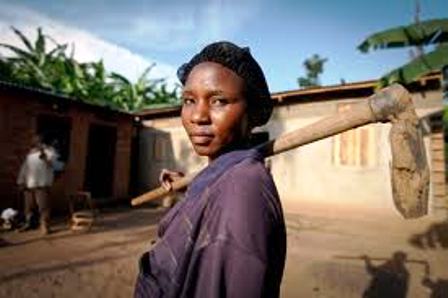
Details of the horrific, genocidal acts against the Banyoro are well documented in “Breaking Chains of Poverty”, published by the Bunyoro Kitara Kingdom Advocacy Publications; authored by the Hon. Yolamu Ndoleriire Nsamba, Principal Private Secretary to H.M Solomon Gafabusa Iguru I, Omukama of Bunyoro-Kitara.
This book is a “must read” for anyone interested in the History and welfare of Bunyoro-Kitara. It enumerates Historical events, plus practices, past and present, that made Bunyoro-Kitara “a kingdom bonded in chains of poverty”.
Omukama of Bunyoro is the title given to rulers of the central African kingdom of Bunyoro-Kitara.
The kingdom lasted as an independent state from the 16th to the 19th century. The Omukama of Bunyoro remains an important figure in Ugandan politics, especially among the Banyoro people of whom he is the titular head.
The Royal Palace, called Karuziika Palace, is located in Hoima. The current Omukama is Solomon Iguru I and his wife is the Queen or Omugo Margaret Karunga.
As a cultural head, the King is assisted by his Principal Private Secretary, a Cabinet of 21 Ministers and a Orukurato (Parliament).
Omukama of Bunyoro/ History of the Omukama of Bunyoro-Kitara dynasties Omukama of Bunyoro is the title given to ruler of the central African kingdom of Bunyoro-Kitara.
The kingdom lasted as an independent state from the 16th to the 19th century. The Omukama of Bunyoro remains an important figure in Ugandan politics, especially among the Banyoro people of whom he is the titular head.
Royal Traditions and Empaango Ceremony
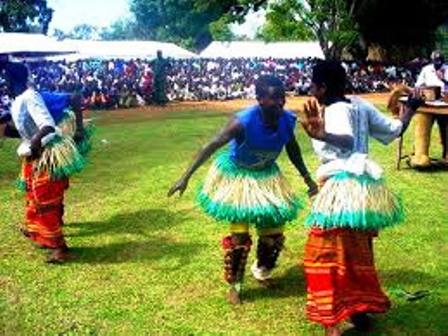 Royal Traditions and Empaango Ceremony
Royal Traditions and Empaango CeremonyEvery year an "Empago" ceremony is held celebrating the King and the Kingdom. The celebration is held at the Royal Palace and all the Banyoro people are invited to join.
During this ceremony the King also beats the Royal Drums as a sign of his power and as a mean of signaling the people. The celebration contains singing, dancing, music and much other.
The Batembuzi Dynasty in Bunyoro Kitara
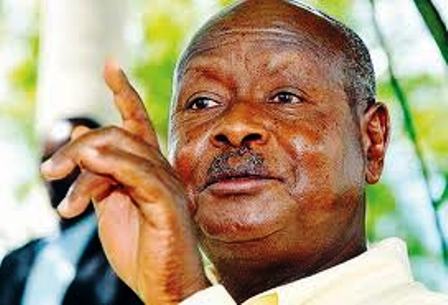
The first kings were of the batembuzi dynasty. Batembuzi means harbingers or pioneers.
The batembuzi and their reign are not well documented, and are surrounded by a lot of myth and oral legend.
There is very little concurrence, among scholars, regarding the Batembuzi time period in history, even the names and successive order of individual kings.
It is believed that their reign dates back to the height of Africa's Bronze Age. The number of individual batembuzi reigns, as given by different scholars, ranges from nine to twenty one.
The Bachwezi Dynasty in Bunyoro Kitara
The Bachwezi are credited with the founding of the ancient empire of Kitara; which included areas of present day central, western, and southern Uganda; northern Tanzania, western Kenya, and eastern Congo.
Very little is documented about them. Their entire reign was shrouded in mystery, so much so that they were accorded the status of demi gods and worshipped by various clans.
Many traditional gods in Toro, Bunyoro and Buganda have typical kichwezi (adjective) names like Ndahura, Mulindwa, Wamara, Kagoro, etc.
The bachwezi dynasty must have been very short, as supported by only three names of kings documented by historian.
The bachwezi kings were Ndahura, Mulindwa and Wamara; in this order. In addition to founding the empire of Kitara, the bachwezi are further credited with the introduction of the unique, long horned ankole cattle, coffee growing, iron smelting, and the first semblance of organized and centralized government, under the king.
No one knows what happened to the Bachwezi. About their disappearance, there is no shortage of colorful legend. One legend claims that they migrated westward and disappeared into Lake Mwitanzige (Albert). Another legend has them disappearing into lake Wamala, which bears the name of the last king of the dynasty.
There is a popular belief among scholars that they simply got assimilated into the indigenous populace, and are, today, the tribal groups like the bahima of Ankole and the batutsi of Rwanda. The bahima and batutsi have the elegant, tall build and light complexion of the bachwezi, and are traditionally herders of the long horned Ankole cattle.
The Babiito Dynasty in Bunyoro Kitara
The Bachwezi dynasty was followed by the Babiito dynasty of the current Omukama of Bunyoro-Kitara. Any attempt to pinpoint the dates of this, or any other dynasty before it, is pure conjecture; as there were no written records at the time.
Modern day historians place the beginning of the Babiito dynasty at around the time of the invasion of Bunyoro by the Luo from the North.
The first mubiito (singular) king was Isingoma Mpuga Rukidi I, whose reign is placed around the 14th century. To date, there have been a total of 27 Babiito kings of Bunyoro-Kitara.
List of Bunyoro Omukamas (Babiito Dynasty)
 List of Bunyoro Omukamas (Babiito Dynasty)
List of Bunyoro Omukamas (Babiito Dynasty)- Rukidi of Bunyoro - late fifteenth century
- Ocaki of Bunyoro - late fifteenth/early sixteenth century
- Oyo Nyiba of Bunyoro - early sixteenth century
- Winyi I of Bunyoro - early sixteenth century
- Olimi I of Bunyoro- mid sixteenth century
- Nyabongo of Bunyoro - mid sixteenth century
- Winyi II of Bunyoro - late sixteenth century/early seventeenth century
- Olimi II of Bunyoro - mid seventeenth century
- Nyarwa of Bunyoro - mid seventeenth century
- Cwamali of Bunyoro - mid seventeenth century
- Masamba of Bunyoro - late seventeenth century
- Anabwani I of Bunyoro, - late seventeenth century
- Kyebambe I of Bunyoro - late seventeenth century
- Winyi III of Bunyoro - early eighteenth century
- Nyaika of Bunyoro - early eighteenth century
- Kyebambe II of Bunyoro - early eighteenth century
- Olimi III of Bunyoro - c. 1710-1731
- Duhaga of Bunyoro - 1731- c. 1782
- Olimi IV of Bunyoro - c. 1782-1786
- Nyamutukura Kyebambe III of Bunyoro- 1786-1835
- Nyabongo II of Bunyoro - 1835-1848
- Olimi V of Bunyoro - 1848-1852
- Kyebambe IV of Bunyoro - 1852-1869
- Kabalega of Bunyoro- 1869-1898
- Kitahimbwa of Bunyoro- 1898-1902
- Duhaga II of Bunyoro - 1902-1924
- Winyi IV of Bunyoro - 1925-1967
- From 1967 until 1994 the monarchy was discontinued by the Ugandan government
- Solomon Iguru I- 1994–present
Other Tribes in the Region
Kenya Cultural Origins | Kenya Student Rules | Kikuyu People | Luo in Kenya | Masai People | Samburu People | Student Class Rules | Turkana People in Kenya |
Recent Articles
-
Garam Masala Appetizers ,How to Make Garam Masala,Kenya Cuisines
Sep 21, 14 03:38 PM
Garam Masala Appetizers are originally Indian food but of recent, many Kenyans use it. Therefore, on this site, we will guide you on how to make it easily. -
The Details of the Baruuli-Banyara People and their Culture in Uganda
Sep 03, 14 12:32 AM
The Baruuli-Banyala are a people of Central Uganda who generally live near the Nile River-Lake Kyoga basin. -
Guide to Nubi People and their Culture in Kenya and Uganda
Sep 03, 14 12:24 AM
The Nubians consist of seven non-Arab Muslim tribes which originated in the Nubia region, an area between Aswan in southern
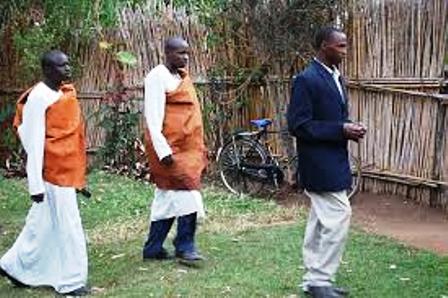

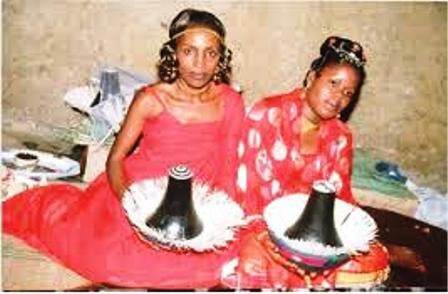
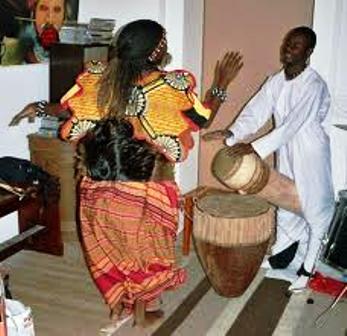
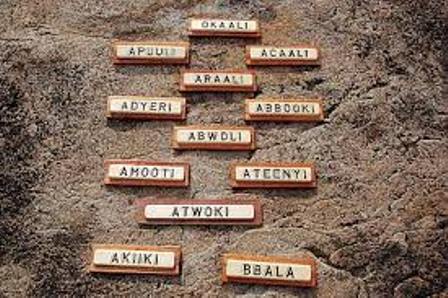
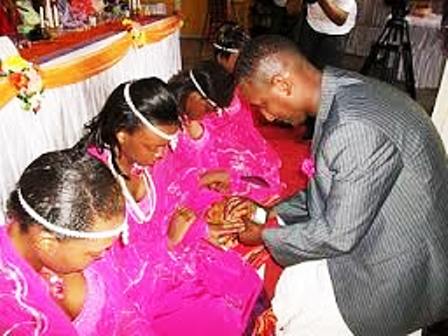
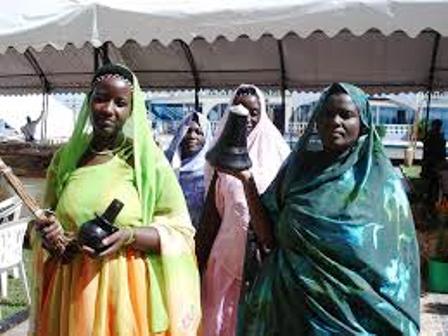
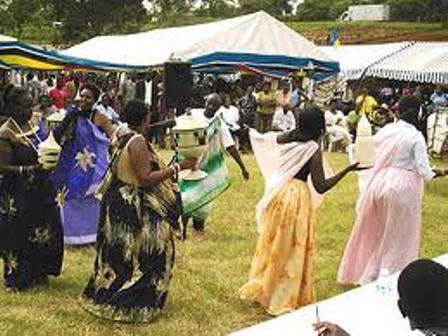
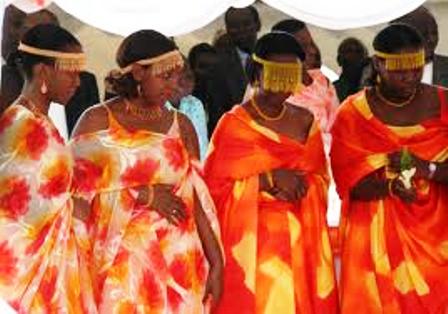
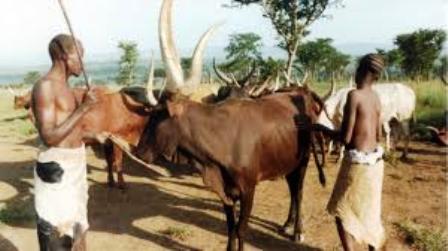







New! Comments
Have your say about what you just read! Leave me a comment in the box below.